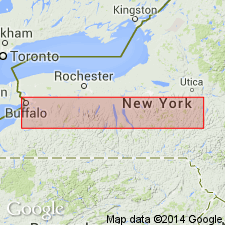
- Usage in publication:
-
- Deep Run member
- Modifications:
-
- Named
- Dominant lithology:
-
- Shale
- AAPG geologic province:
-
- Appalachian basin
Summary:
Deep Run member of Ludlowville formation named in this report for Deep Run ravine, near Cottage City, Canandaigua Lake, central NY. Unit is brittle bluish shale overlying true Tichenor limestone and underlying Menteth limestone (basal bed of Portland Point member of Ludlowville formation. Contains a variety of pelecypods and great abundance of large specimens of TROPIDOLEPTUS CARINATUS. Member is recognizable from Seneca Lake to Hills Gulch, 5 mi south of LeRoy. At type locality, 55 ft thick, but diminishes rapidly to west. At Jacox Run, Genesee Valley, 9 ft thick, at Hills Gulch, about 3 ft and from there tapers to feather edge. Also diminishes in thickness east of type locality, measuring 49 ft on Kashong Creek. Not distinguished east of Seneca Lake, but it evidently forms upper part of King Ferry member to east. Age is Middle Devonian.
Source: GNU records (USGS DDS-6; Reston GNULEX).
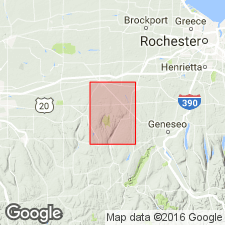
- Usage in publication:
-
- Deep Run member
- Modifications:
-
- Areal extent
- AAPG geologic province:
-
- Appalachian basin
Summary:
Deep Run member of Ludlowville shale is 55 ft thick at type locality, but thins rapidly westward until it wedges out in Batavia quad. Crops out in eastern part of Batavia quad, 0.75 mi southeast of Pavilion Center. Here consists of 3.6 ft of calcareous shale and is overlain by Menteth limestone, 0.6 ft thick.
Source: GNU records (USGS DDS-6; Reston GNULEX).
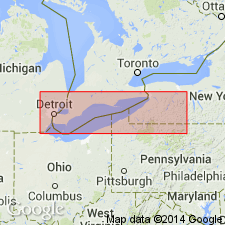
- Usage in publication:
-
- Deep Run formation
- Modifications:
-
- Revised
- AAPG geologic province:
-
- Appalachian basin
Summary:
Referred to as Deep Run formation. Thickness 10 ft. Overlies Tichenor formation; underlies Menteth formation. Ostracodes discussed.
Source: GNU records (USGS DDS-6; Reston GNULEX).
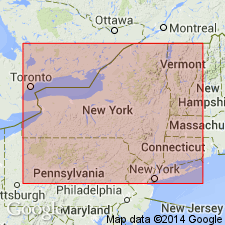
- Usage in publication:
-
- Deep Run Member
- Modifications:
-
- Overview
- AAPG geologic province:
-
- Appalachian basin
Summary:
Deep Run Member of Moscow Formation consists of hard bluish gray, calcareous, and typically highly bioturbated silty mudstones. Becomes a calcareous silty mudstone or siltstone with well preserved ZOOPHYCOS spreiten in eastern outcrops. Basal 0.5 to 1.5 m is richer in fossils, particularly the branching coral HELIOPHYLLUM PROLIFERUM, which is diagnostic of this interval. Also contains crinoid columns, bryozoans, gastropods, brachiopods, and trilobites. Upper beds of the Deep Run are relatively homogenous in appearance and contain only scattered fossils. Unit is thickest (18 m) at its type section on the east side of Canandaigua Lake and thins both southeastward and westward so that it appears as a large scale lens in cross section. Gradationally overlies the Tichenor Limestone Member and gradationally underlies the Menteth Limestone Member in the basin center. Age is Middle Devonian (Givetian).
Source: GNU records (USGS DDS-6; Reston GNULEX).
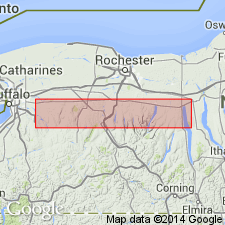
- Usage in publication:
-
- Deep Run Shale Member*
- Modifications:
-
- Overview
- AAPG geologic province:
-
- Appalachian basin
Summary:
Author follows usage of Baird (1979) who reassigned Tichenor Limestone Member and Deep Run Shale Member from Ludlowville Formation to Moscow Formation, both of Hamilton Group. Deep Run shown as middle Givetian. Contains coral HELIOPHYLLUM DELICATUM.
Source: GNU records (USGS DDS-6; Reston GNULEX).
For more information, please contact Nancy Stamm, Geologic Names Committee Secretary.
Asterisk (*) indicates published by U.S. Geological Survey authors.
"No current usage" (†) implies that a name has been abandoned or has fallen into disuse. Former usage and, if known, replacement name given in parentheses ( ).
Slash (/) indicates name conflicts with nomenclatural guidelines (CSN, 1933; ACSN, 1961, 1970; NACSN, 1983, 2005, 2021). May be explained within brackets ([ ]).

